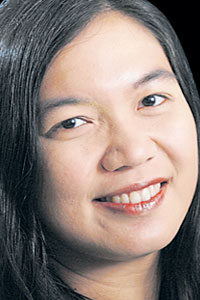Over two years ago, I wrote about my contentment with a new trend in which a number of Thais wear traditional costumes in everyday life. Today, I feel happier since so many Thai people opt for traditional outfits and the style is even recognised and promoted by the government. I must note this was ignited by the craze for the periodical TV series Bupphesanniwat (Love Destiny), which was about the time journey of an archaeologist to the reign of Ayutthaya's King Narai the Great over 300 years ago.
In conjunction with the popularity of the series, the government is armed with a policy to conserve Thai culture and revive the traditional style of Songkran celebrations while the Culture Ministry enhances the connection of Thai history, archaeology, Thai delicacies, tourism and traditional Thai fabrics. Anyone can see Prime Minister Prayut Chan-o-cha regularly wears shirts tailored from Thai textiles.
During the Songkran (Thai New Year) Festival, those wearing traditional Thai costumes to any of the nine historical parks nationwide from last Thursday to today are exempt from payment of admission fees under the Fine Arts Department's special regulation. The nine parks are Ayutthaya Historical Park in Ayutthaya, Sukhothai Historical Park and Si Satchanalai Historical Park in Sukhothai, Kamphaeng Phet Historical Park in Kamphaeng Phet, Phanom Rung Historical Park in Buri Ram, Phimai Historical Park in Nakhon Ratchasima, Muang Singh Historical Park in Kanchanaburi, Sri Thep Historical Park in Phetchabun and Phu Phra Bat Historical Park in Udon Thani.
Also during Songkran, the Tourism Authority of Thailand (TAT) has organised Songkran celebrations in Bangkok and 12 major tourist destinations nationwide and five emerging secondary destinations known for outstanding Thai New Year traditions -- Sing Buri, Chanthaburi, Kamphaeng Phet, Kalasin and Nakhon Si Thammarat -- from last Wednesday until tomorrow.
Interestingly, the TAT has a campaign for Thai people to return to their hometowns and wear traditional Thai outfits to enjoy Songkran festivities and spend quality time with families under the concept of "Going Home And Wearing Thai To Enjoy Songkran".
Even the private sector and some Buddhist temples and museums promote the trend. For example, at the weekend, tourists were encouraged to don Thai traditional outfits to the "13th Nang Yai Wat Khanon" Festival that took place at Wat Khanon in Photaram district, Ratchaburi province, under the theme of "Watching Nang Yai, Wearing Traditional Thai Costumes, Visiting Dan Khanon Market". Visitors in Thai outfits watched nang yai (shadow puppet shows) in the evening and enjoyed shopping at a retro-style market using reproductions of ancient money called bia all day.
From last Thursday until today, visitors have been asked to don traditional Thai costumes to the "A Glimpse At Rattanakosin" fair featuring authentic Thai cuisine according to the recipes of Princess Saisawalibhirom, one of King Rama V's wives. The fair is being held at a Bangkok shopping mall.
From early in March until now, Muang Boran, or Ancient Siam, a themed park in Samut Prakan, with models of heritage sites nationwide, welcomes visitors wearing traditional Thai costumes to visit the park.
As a matter of fact, a few cultural attractions, including Lop Buri's Phra Narai Ratchaniwet Palace and Phetchaburi's Phra Nakhon Khiri Palace or Khao Wang, have been promoting the trend for several years.
Every February, the public and private sector of Lop Buri invite locals and tourists to wear traditional Thai costumes to the annual "Land Of King Narai The Great Fair" at Phra Narai Ratchaniwet National Museum. This year is extraordinary because almost everyone in this province donned traditional outfits in daily life from Jan 9 to Feb 18.
Besides special events, social networking works well. For instance, a Facebook fan page called "Taeng Thai Sabai Ngam Siam Phusa Niyom" (Wearing Beautiful Thai Costumes And Sabai) with more than 15,000 members promotes wearing traditional costume in everyday life. It gives advice on styles, shops and events and serves as a forum for members to discuss related topics and share pictures.
Despite all these supportive strategies, the trend may not be sustainable unless some misperceptions about the formality of the outfits fade away. For example, I am uncertain whether the ban on women wearing a sinh (a traditional tube skirt) to the Government House and Parliament persists. I wonder why donning sinhs is deemed inappropriate although sinhs were once acceptable as a civilised dress style for Thai women. Under Field Marshal Plaek Phibunsongkhram's ultra-nationalist governments (1938-1944 and 1948-1957), Thais were encouraged to wear hats and Western-style outfits: shirts, smart trousers or Thai-style short trousers for men and blouses and sinh for women.
No matter whether the Thai people's passion for traditional costumes is temporary or sustainable, it definitely stimulates public awareness of the importance of Thai art, culture and heritage.
Pichaya Svasti is a travel writer of the Life section of the Bangkok Post.
